Using Shopify's native reports can often get you stuck in the weeds: downloading CSVs, sifting through line items, and manually categorizing fees, taxes, and refunds. It’s not only workflow-heavy, it’s risky. Misreporting VAT or overlooking transaction fees can quietly eat away at your margins.
And most sellers think they’re doing it right… until tax season hits.
Link My Books is your automated finance assistant for Shopify. It reconciles transactions, maps tax codes, and integrates directly with Xero or QuickBooks, so you can ditch the spreadsheets and trust your numbers.
Key Takeaways from this Post
Shopify’s built-in reports are helpful - but far from complete.
Manual reconciliation leads to mistakes and wasted hours.
Link My Books automates Shopify reporting and tax mapping, so you can focus on growing your store.







Where Most Sellers Go Wrong with Shopify Transaction Reports
Most guides on Google walk you through how to find a Shopify transaction report, but they don’t show you the real issue:
Shopify’s reports aren’t designed for accounting.
They’re built for basic analytics, not accurate tax filings or bookkeeping. You get line items, not summaries. Payout mismatches, missing VAT breakdowns, and manual errors are common. Sellers then either misfile taxes or overpay without realizing it.
We don’t just tell you what to download. We’ll show you the smarter way, you can skip the spreadsheets and let automation do the heavy lifting.
There’s a Smarter Way to Handle Shopify Bookkeeping
Manual processes kill your time and introduce risk. Link My Books eliminates both.
Instead of exporting raw reports and manually reconciling, you can:
- Automatically import all sales, fees, and tax data from Shopify
- Categorize transactions correctly for tax and accounting
- Post directly into Xero or QuickBooks
- Reconcile payouts with one click
Automate the Entire Process with Link My Books
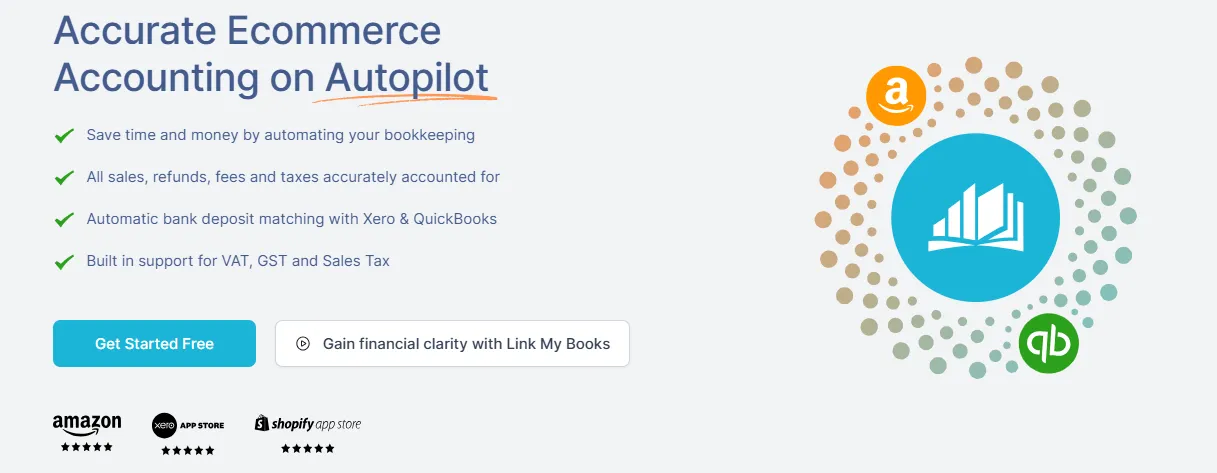
That means no more copy-paste errors, no missed VAT, and no wasted weekends.
Here’s how to do it:
Step 1: Connect Your Shopify and Accounting Platforms
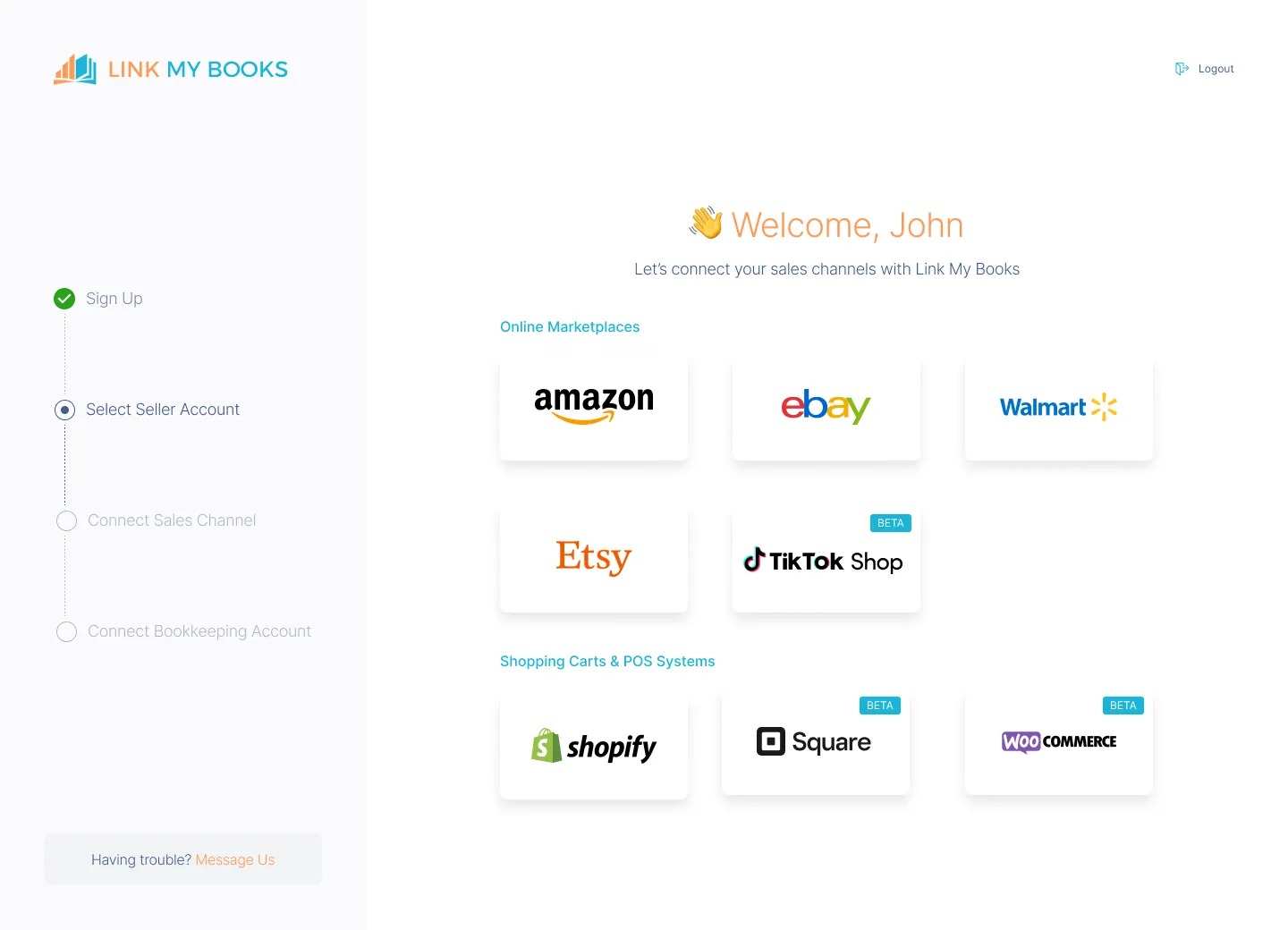
- Sign up for Link My Books and link your Shopify store.
- Then, connect your Xero or QuickBooks account.
- Set your tax preferences once, and Link My Books applies them automatically from there.
Step 2: Pull In Your Data Automatically

- Link My Books imports every Shopify sale, refund, fee, and tax in real time.
- You’ll never miss a transaction or misreport a payout again.
Step 3: Clean, Categorized Summaries in Your Accounting Software
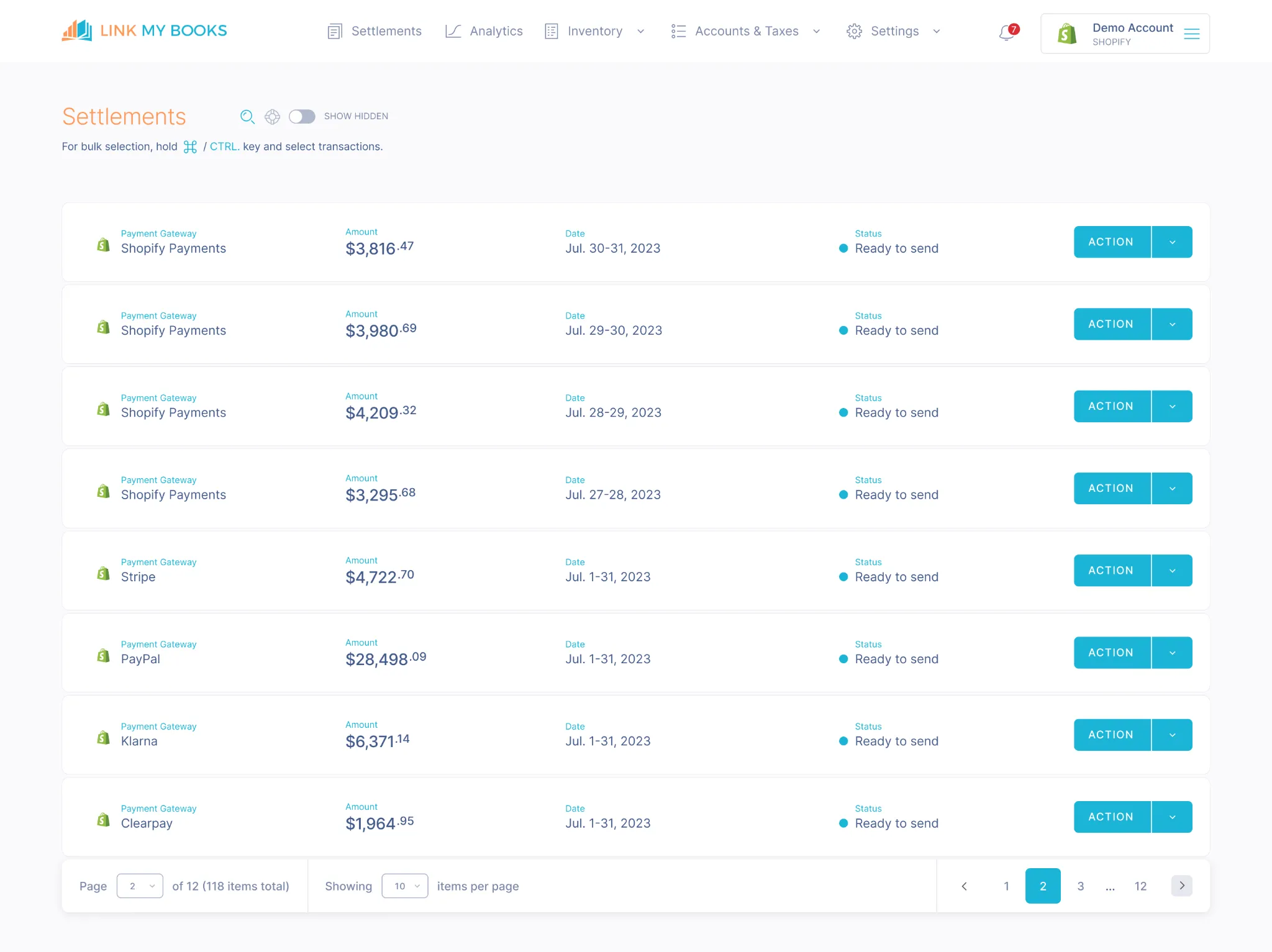
- Transactions are automatically grouped and categorized, ready for review.
- COGS tracking is included, so you get an accurate view of your profit margins.
Step 4: Reconcile with a Single Click
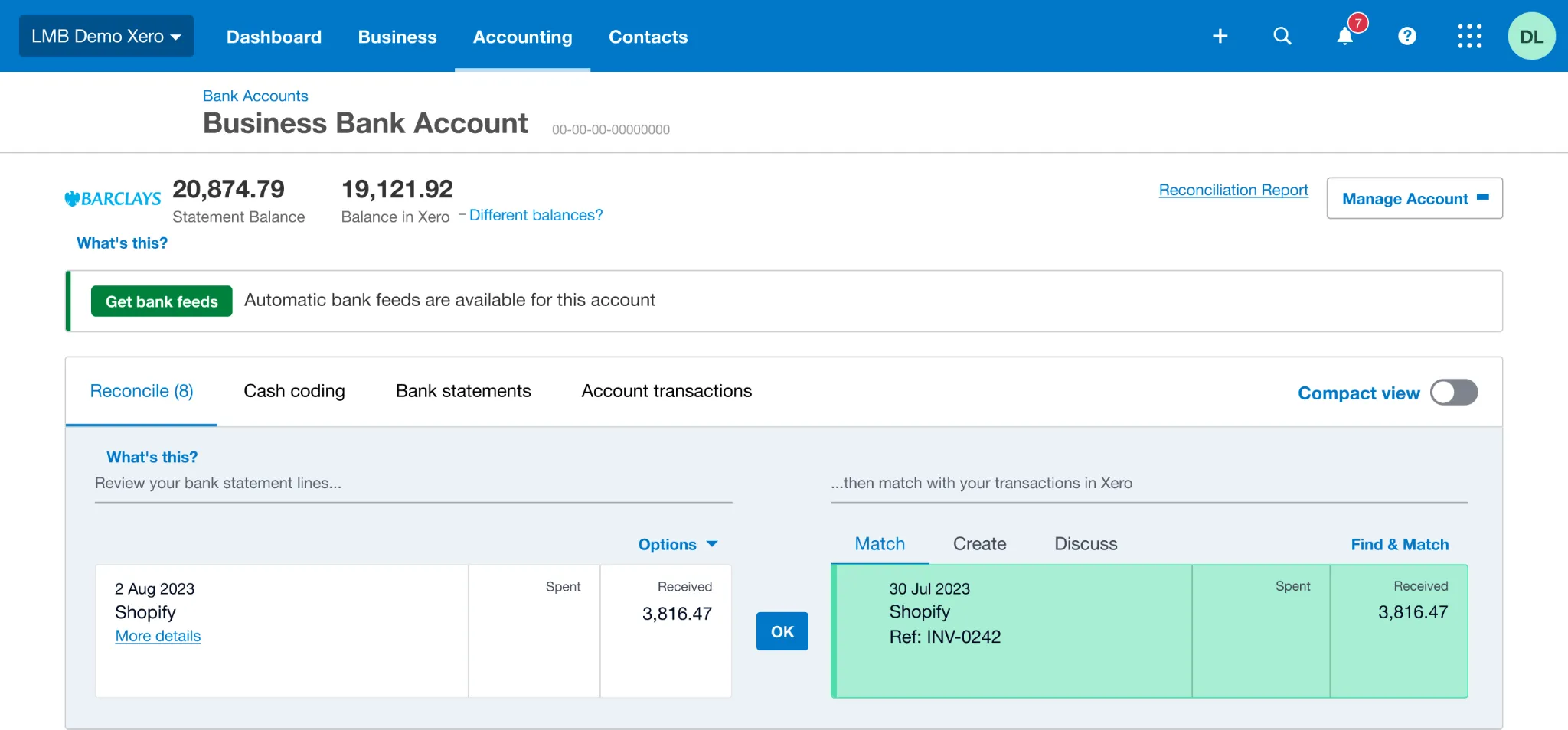
- Each Shopify payout is matched directly with your bank deposits.
No spreadsheets. No stress. No room for human error.
🔹 With Link My Books, your Shopify bookkeeping is fully automated, giving you back hours of time each month.
And you can try it out for free, you don’t even need a credit card!

But if you still insist on doing it the manual way, here’s how:
How to Get a Transaction Report on Shopify
- Step #1: Log in to Shopify Admin
- Step #2: Access Finances > Payouts
- Step #3: Export Your Transaction Report
Step #1: Log in to Shopify Admin
Go to shopify.com, and log into your store. Make sure you have admin-level permissions.
Step #2: Access Finances > Payouts
In your Shopify admin:
- Navigate to Settings > Payments
- Click View payouts
- You’ll see a breakdown of your most recent and pending payouts
For tax purposes, this doesn’t show everything you need (like location-based tax breakdowns), but it’s the closest thing Shopify offers.
Step #3: Export Your Transaction Report
- Click Transactions
- Set your date range
- Hit Export CSV
You’ll get a file with transaction types, payment methods, gross amounts, and fees. It’s helpful, but it doesn’t calculate VAT, and it won’t match payouts unless you do it all manually.
How Link My Books Makes Accounting for Shopify Simple

Link My Books removes the pain points that Shopify’s native reports create.
✅ Direct integration with Xero & QuickBooks
✅ Auto-categorizes sales, refunds, fees, and taxes
✅ Maps VAT rates for each product automatically
✅ Summarizes payouts so they reconcile with your bank
✅ One-click sync - choose manual or AutoPost mode
With Link My Books, you can save valuable time on your bookkeeping tasks and focus on growing your e-commerce business.
It integrates directly with Xero and QuickBooks, Link My Books also offers a dedicated support team of experienced accountants who understand the unique challenges faced by e-commerce sellers. They can provide guidance and assistance with setup, reconciliation, and troubleshooting, ensuring that you get the most out of your dedicated Shopify accounting software and avoid costly mistakes.
Here’s what to expect:
Accurate Tax Calculations

Link My Books automatically applies the correct tax rates to each transaction, including VAT, GST, and sales tax, ensuring compliance with local regulations.
Detailed Reporting

Link My Books creates clear, organized summaries of your every payout, breaking them down into sales, refunds, and fees for a full financial overview.
Cost of Goods Sold (COGS) Tracking

This feature automates the allocation of sold inventory as a COGS expense and gives you accurate profit calculations.
User-Friendly Setup
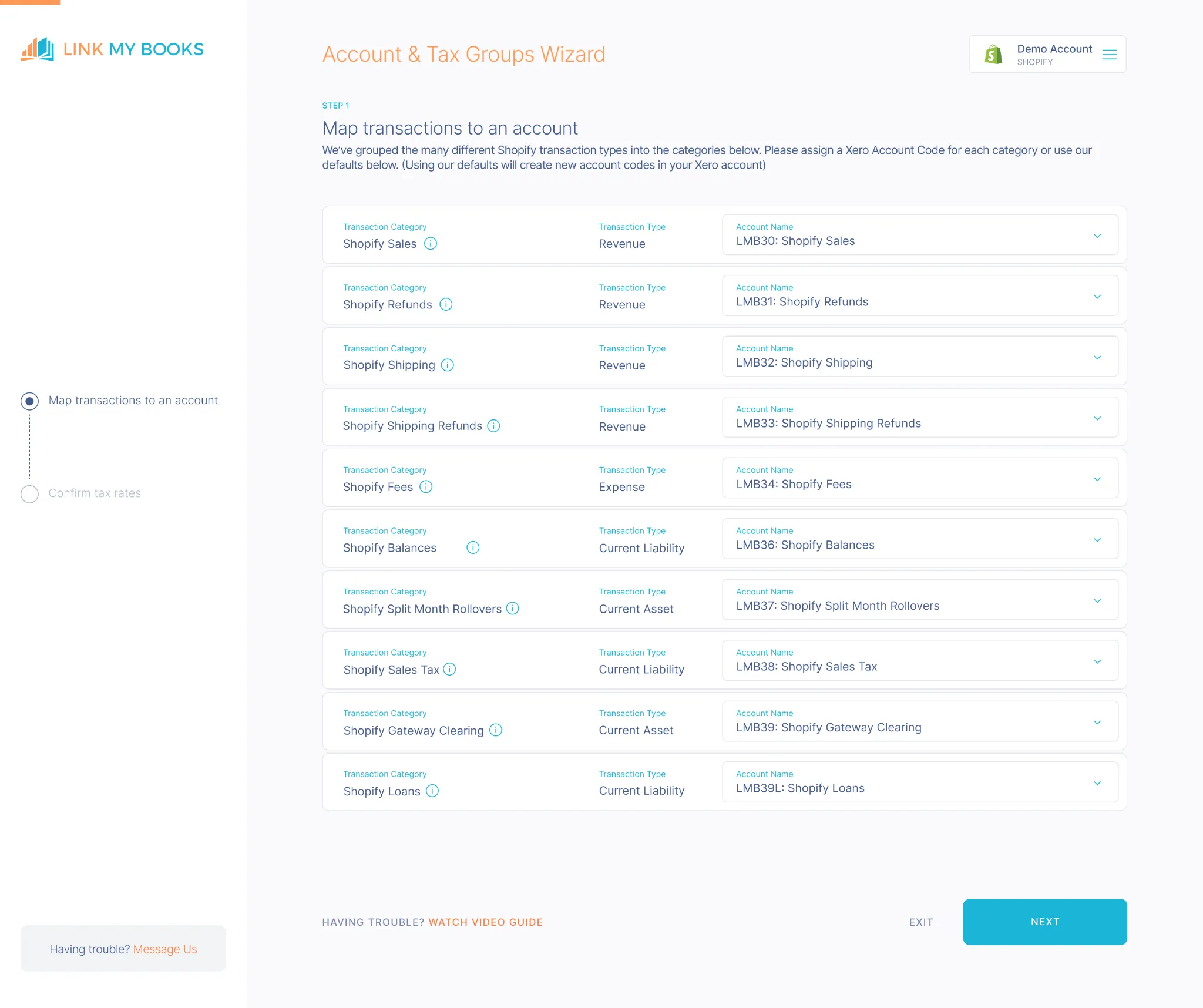
The guided setup wizard is simple to use and you can also opt for free 1:1 onboarding calls if you need assistance in configuring your accounts.
Whether you’re processing a handful of orders or hundreds each day, Link My Books scales with your business, simplifying your workflow no matter how complex your operation gets.
Start your free trial today and streamline your sales reporting.

🗣️ “Link My Books has been a game changer for our business.” – Shopify Seller, UK
Essential Shopify Transaction Report Figures to Know
How to Use Shopify Transaction Report Figures for VAT Calculation

Shopify doesn’t automatically break down VAT unless you’ve configured it perfectly. Even then, it can miss:
- Zero-rated and reduced-rate items
- Overseas vs domestic sales
- OSS or IOSS schemes
With Link My Books, VAT is handled automatically:
- Assigns products to tax groups (standard, reduced, zero-rated)
- Calculates VAT per region (UK, EU, international)
- Posts summary invoices into Xero or QuickBooks with the correct codes
You’ll never overpay, or underreport, on your Shopify VAT again.

Common Challenges with Shopify Transaction Reports
Bookkeeping through Shopify alone may seem convenient, until it isn’t. The reality is, native Shopify reports fall short when it comes to real-world accounting, compliance, and time management. Here’s where most sellers hit a wall:
Limitations of Native Shopify Reporting
Shopify reports are designed for high-level business analytics, not accounting precision.
- No VAT breakdowns by country or product: Shopify doesn’t clearly separate domestic from international tax regions. This makes it hard to stay compliant with regulations like UK VAT or the EU’s One-Stop-Shop (OSS) scheme.
- No summary invoices: Shopify exports line-item data but doesn’t offer clean summaries for accounting platforms. This forces sellers to manually group transactions, a recipe for mistakes.
- Lack of reconciliation-ready data: You won’t find clear links between payouts and order data, which makes matching deposits to your sales report time-consuming and error-prone.
💡 If you're VAT registered, relying on Shopify alone increases your risk of filing incorrect returns, or overpaying tax entirely.
Manual Data Entry and Reconciliation Issues
Trying to reconcile Shopify payouts manually? You’re in for a long ride.
- Exporting multiple reports: Sellers often need to pull several CSV files just to capture sales, refunds, taxes, and fees.
- Copy-pasting into spreadsheets: A single typo can throw off your entire VAT return or profit calculation.
- Inconsistent mapping: Without automation, there's no guarantee your categories align with your chart of accounts in Xero or QuickBooks.
This isn’t just frustrating, it’s financially risky. Manual errors can lead to:
- Overstated or understated revenue
- Missed tax liabilities
- Poor decision-making based on inaccurate margins
With Link My Books, all of this is automated. It pulls clean, organized data from Shopify and posts directly into your accounting software, no spreadsheets required.
Time Constraints for Busy Business Owners
Let’s face it: sellers don’t have time to be part-time accountants.
- Bookkeeping often gets pushed to the bottom of the to-do list.
- Month-end reporting becomes a rushed, stressful task.
- Compliance errors can creep in when you're short on time and energy.
Even if you outsource your bookkeeping, your accountant will still need accurate, categorized data. Giving them messy Shopify exports only delays the process and increases your billable hours.
That’s why tools like Link My Books aren’t just about automation, they’re about reclaiming time. What used to take you hours every week can now be done in minutes per month, with full confidence your numbers are accurate.
Why Do You Need a Shopify Transaction Report?
Understanding your Shopify transaction data isn’t just about knowing how many orders you’ve processed. It’s about getting clear, actionable financial insights that help you stay compliant, profitable, and in control of your business.
1. Tax Compliance
Shopify collects some tax data, but it doesn’t file your VAT returns or tell you exactly what you owe. That’s on you.
If you’re VAT-registered (like many UK sellers), you’re legally required to report accurate figures for:
- Sales by region (UK, EU, International)
- Tax collected vs tax due
- Zero-rated vs standard-rated products
Shopify’s standard reports won’t break this down for you in a VAT-compliant format. That’s why a clean, categorized transaction report is essential, especially when dealing with OSS or cross-border sales.
Link My Books solves this by auto-applying VAT rules and generating compliant reports, ready for your accountant or direct filing.
2. Financial Clarity
Shopify shows gross sales, but that’s only part of the story.
To understand your true earnings, you need to factor in:
- Platform fees (Shopify Payments, transaction fees, app fees)
- Discounts and refunds
- Shipping costs
- Taxes collected or paid
A transaction report helps you calculate your net revenue, the actual money you keep after all deductions. Without this, you’re guessing your profit margins, which makes pricing, marketing, and budgeting decisions shaky at best.
3. Payout Reconciliation
Each time Shopify sends you a payout, it’s a mix of dozens (or hundreds) of orders, refunds, fees, and taxes. The number that hits your bank isn’t your gross revenue, so how do you verify that it’s accurate?
Without a transaction report, you’re stuck:
- Manually matching orders to payout totals
- Cross-referencing CSVs and bank statements
- Spending hours trying to reconcile missing data
With Link My Books, payouts are automatically matched to your bank deposits in Xero or QuickBooks, making reconciliation a one-click job.
4. Inventory Planning
Sales reports also play a major role in inventory forecasting and restocking decisions.
Accurate transaction data lets you:
- Spot fast-moving products
- Identify slow sellers draining cash
- Prepare for seasonal demand
- Adjust pricing to protect margins
If you’re tracking inventory manually or reacting based on guesswork, you’re increasing your risk of overselling, stockouts, or tying up too much cash in the wrong SKUs.
A clear transaction report gives you the sales data to plan your next inventory move with confidence.
FAQ on Shopify Seller Sales Tax Reporting

Will Shopify send me a 1099?
- Only if you're in the U.S. and meet the threshold. Otherwise, you'll need to calculate your earnings manually or use an automation tool.
How can I find sales by country on Shopify?
- You’ll need to export transaction data and use filters, or let Link My Books do this automatically.
How far back can I see Shopify sales?
- Shopify lets you view data as far back as your account’s start—but for detailed tax reporting, keep backups or sync with accounting software.
How much do I have to make on Shopify to file taxes?
- In the UK, you must register for VAT once you hit £85,000. In the US, thresholds vary by state.
Does Shopify automatically take out sales tax?
- In some jurisdictions, yes. But you’re still responsible for remitting it or reporting correctly, depending on local laws.
Simplify Accounting for Shopify with Link My Books

Shopify's default reports aren't built for accounting. Without proper transaction reporting, you're flying blind. Whether you're trying to file taxes, forecast stock, or reconcile payouts, a clean, organized report is non-negotiable.
That’s why so many sellers switch to Link My Books. It turns messy Shopify data into clean, tax-ready summaries - automatically.
If you're tired of digging through CSVs, wrestling with spreadsheets, or second-guessing your VAT filings - stop.
Link My Books takes the guesswork out of Shopify accounting:
- Syncs with Shopify, Xero, and QuickBooks
- Maps every order to the right tax treatment
- Reconciles payouts automatically
- Cuts bookkeeping from hours to minutes
Start your free trial today and make tax time painless.
✅ Ready to Save Hours on Bookkeeping? Try Link My Books Free → Automate Shopify reporting. Save time. Stay compliant.










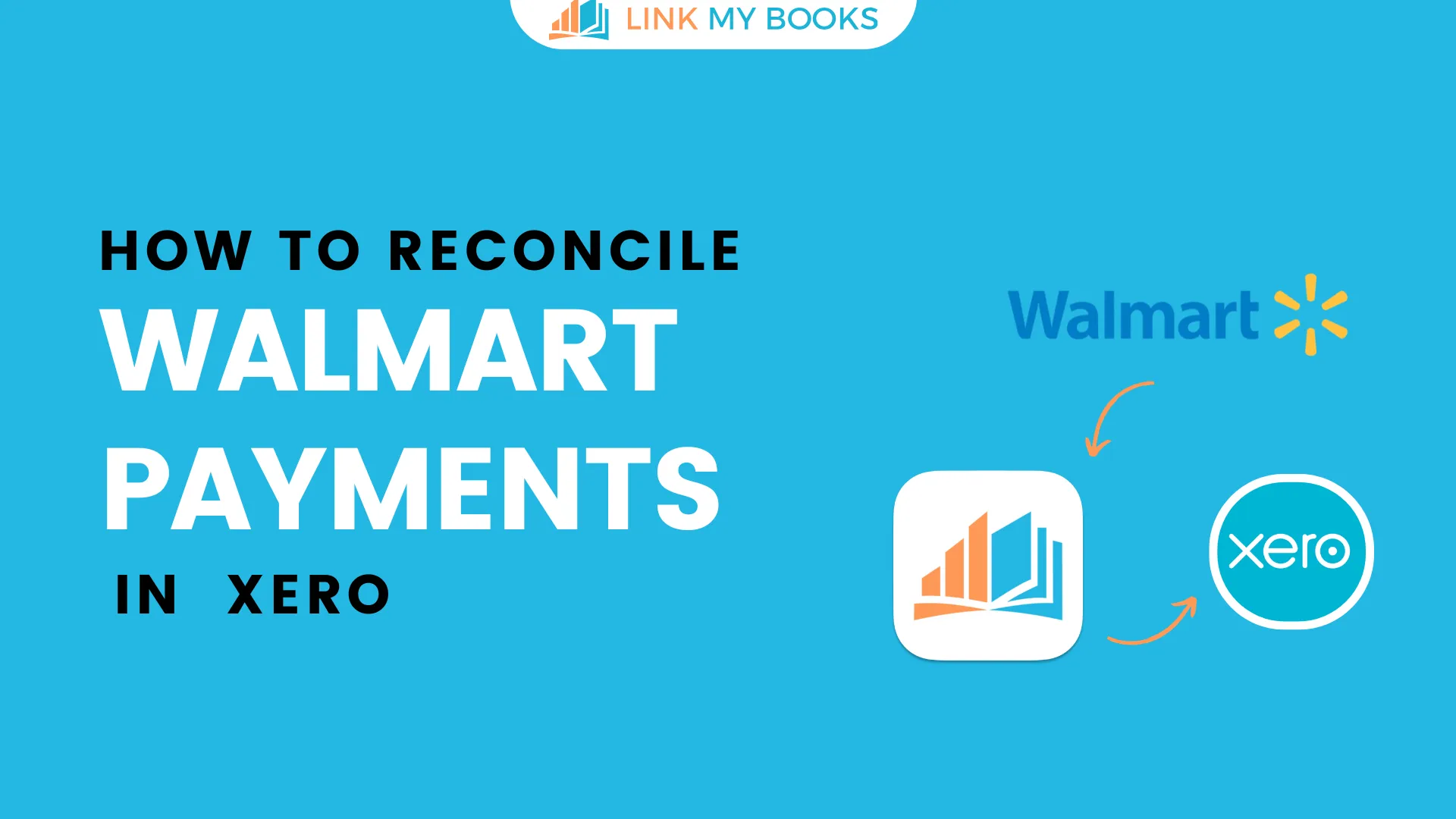
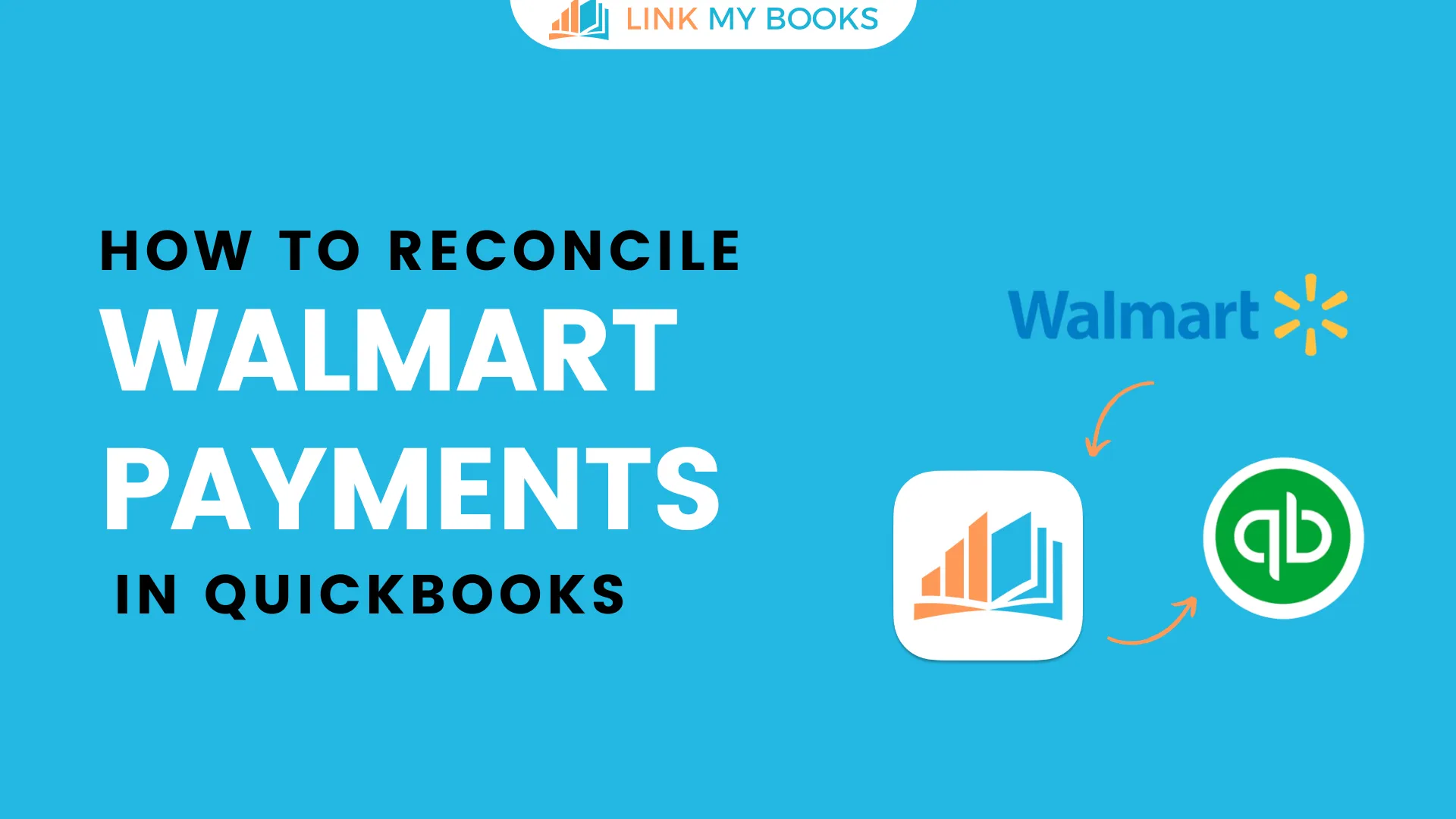
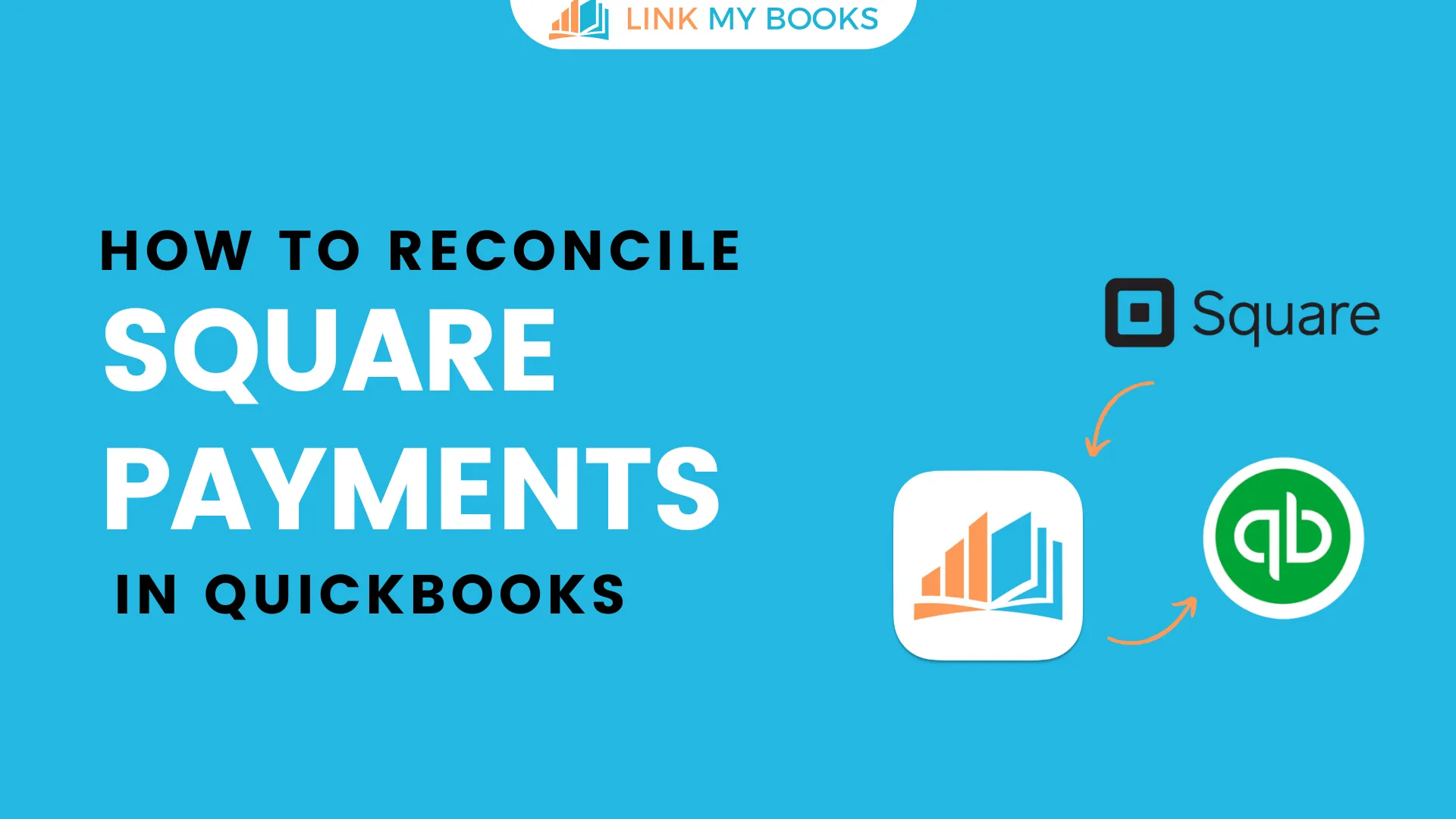
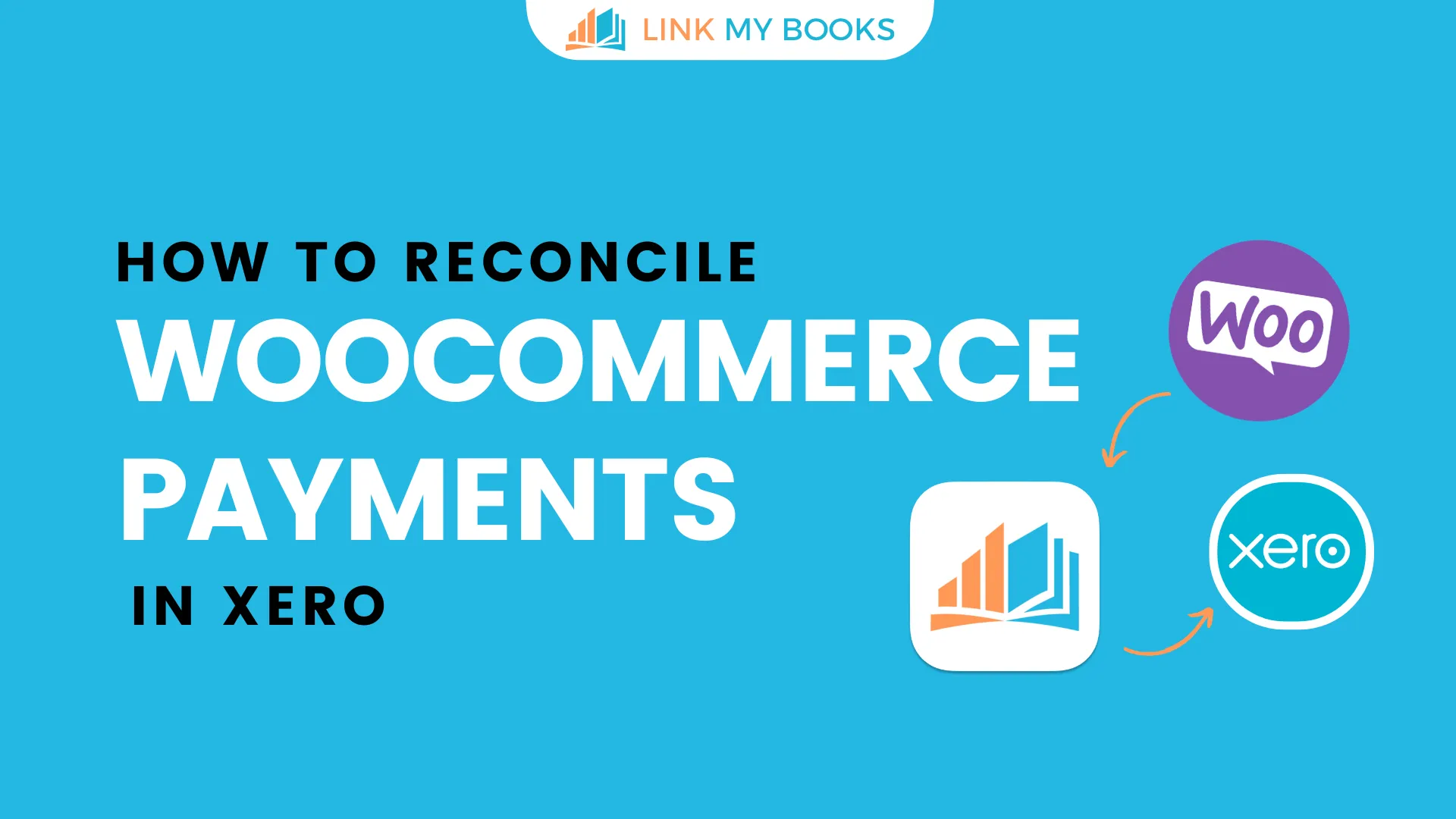
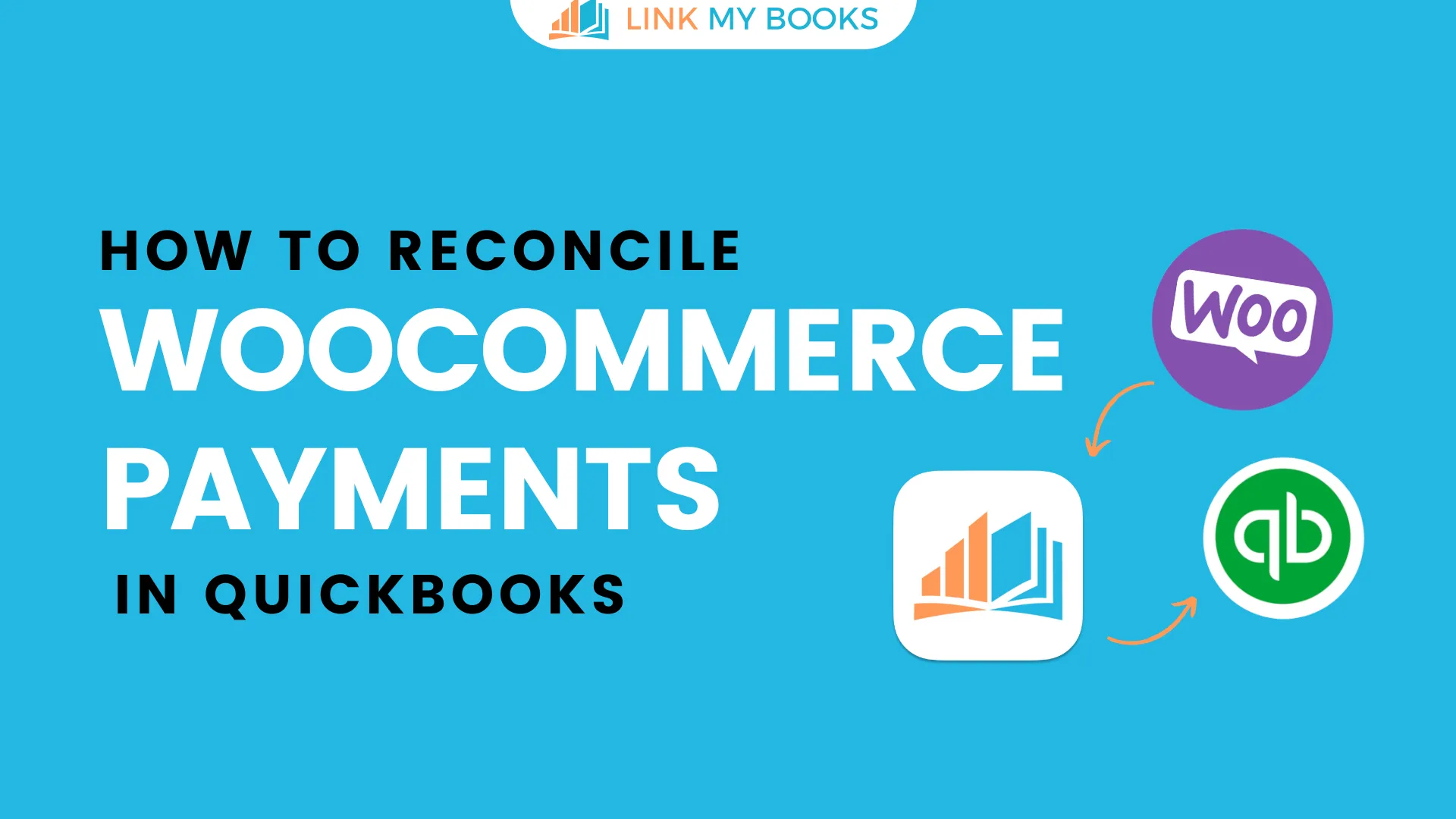
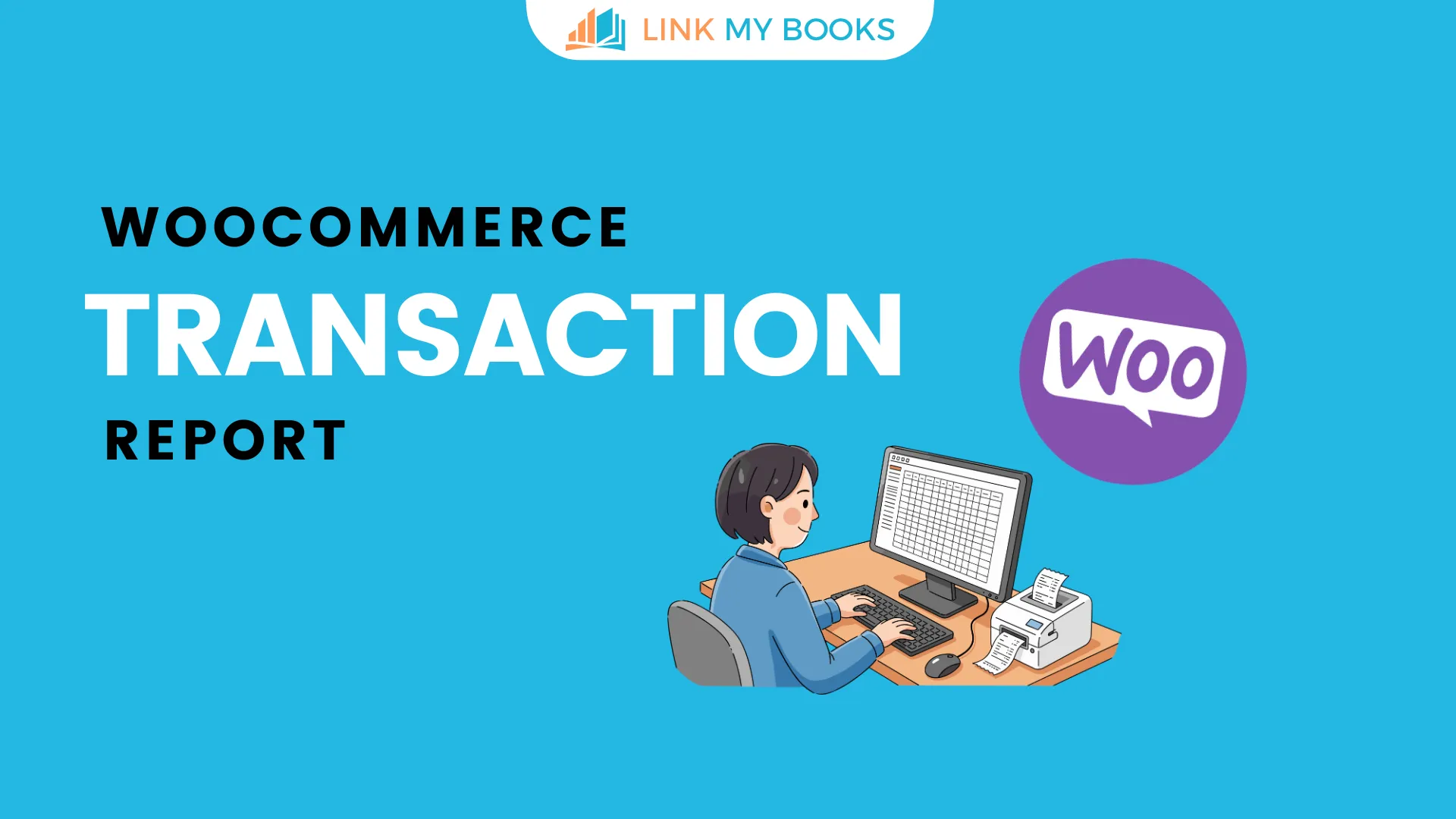


.png)